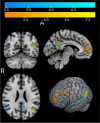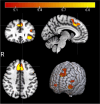Semantic processing in older adults is associated with distributed neural activation which varies by association and abstractness of words
- PMID: 38822124
- PMCID: PMC11493883
- DOI: 10.1007/s11357-024-01216-x
Semantic processing in older adults is associated with distributed neural activation which varies by association and abstractness of words
Abstract
The extent to which the neural systems underlying semantic processes degrade with advanced age remains unresolved, which motivated the current study of neural activation on functional magnetic resonance imaging (fMRI) during semantic judgments of associated vs. unassociated, semantic vs. rhyme, and abstract vs. rhyme word pairs. Thirty-eight older adults, 55-85 years of age, performed semantic association decision tasks in a mixed event-related block fMRI paradigm involving binary judgments as to whether word pairs were related (i.e., semantically associated). As hypothesized, significantly greater activation was evident during processing of associated (vs. unassociated) word pairs in cortical areas implicated in semantic processing, including the angular gyrus, temporal cortex, and inferior frontal cortex. Cortical areas showed greater activation to unassociated (vs. associated) word pairs, primarily within a large occipital cluster. Greater activation was evident in cortical areas when response to semantic vs. phonemic word pairs. Contrasting activation during abstract vs. concrete semantic processing revealed areas of co-activation to both semantic classes, and areas that had greater response to either abstract or concrete word pairs. Neural activation across conditions did not vary as a function of greater age, indicating only minimal age-associated perturbation in neural activation during semantic processing. Therefore, the response of the semantic hubs, semantic control, and secondary association areas appear to be largely preserved with advanced age among older adults exhibiting successful cognitive aging. These findings may provide a useful clinical contrast if compared to activation among adults experiencing cognitive decline due Alzheimer's, frontal-temporal dementia, and other neurodegenerative diseases.
Keywords: Aging; Neural activation; Semantics; fMRI.
© 2024. The Author(s), under exclusive licence to American Aging Association.
Conflict of interest statement
The authors declare no competing interests.
Figures





Similar articles
-
Functional connectivity in distributed cortical networks associated with semantic processing in healthy older adults.Front Aging Neurosci. 2025 May 22;17:1479861. doi: 10.3389/fnagi.2025.1479861. eCollection 2025. Front Aging Neurosci. 2025. PMID: 40475375 Free PMC article.
-
Functional connectivity of brain networks during semantic processing in older adults.Front Aging Neurosci. 2022 Oct 19;14:814882. doi: 10.3389/fnagi.2022.814882. eCollection 2022. Front Aging Neurosci. 2022. PMID: 36337702 Free PMC article.
-
Developmental changes in the neural correlates of semantic processing.Neuroimage. 2006 Feb 15;29(4):1141-9. doi: 10.1016/j.neuroimage.2005.09.064. Epub 2005 Nov 7. Neuroimage. 2006. PMID: 16275017
-
Age-related differences in resolving semantic and phonological competition during receptive language tasks.Neuropsychologia. 2016 Dec;93(Pt A):189-199. doi: 10.1016/j.neuropsychologia.2016.10.016. Epub 2016 Oct 29. Neuropsychologia. 2016. PMID: 27984068 Free PMC article.
-
Age-related changes in the neural networks supporting semantic cognition: A meta-analysis of 47 functional neuroimaging studies.Neurosci Biobehav Rev. 2018 Jan;84:134-150. doi: 10.1016/j.neubiorev.2017.11.010. Epub 2017 Nov 26. Neurosci Biobehav Rev. 2018. PMID: 29183684 Review.
Cited by
-
Functional connectivity in distributed cortical networks associated with semantic processing in healthy older adults.Front Aging Neurosci. 2025 May 22;17:1479861. doi: 10.3389/fnagi.2025.1479861. eCollection 2025. Front Aging Neurosci. 2025. PMID: 40475375 Free PMC article.
References
-
- Paivio A. Mental representations: a dual coding approach. New York: Oxford University Press; 1985.
-
- Doboli A, Umbarkar A, Doboli S, Betz J. Modeling semantic knowledge structures for creative problem solving: studies on expressing concepts, categories, associations, goals and context. Knowl-Based Syst. 2015;78:34–50.
-
- Nelson DL, McEvoy CL, Schreiber TA. The University of South Florida free association, rhyme, and word fragment norms. Behav Res Methods Instrum Comput. 2004;36(3):402–7. - PubMed
-
- Yap MJ, Tan SE, Pexman PM, Hargreaves IS. Is more always better? Effects of semantic richness on lexical decision, speeded pronunciation, and semantic classification. Psychon Bull Rev. 2011;18(4):742–50. - PubMed
MeSH terms
LinkOut - more resources
Full Text Sources
Medical
Research Materials

